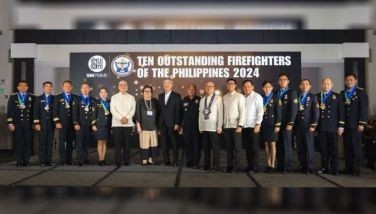Silliman's 50 years of cultural prominence

It’s almost impossible to live four years of your life at Silliman University and not become a hopeless romantic. Whichever career you choose to prepare yourself for — an engineer, a biologist, a nurse, a lawyer, a computer analyst — you have no choice but to swim in the works of Shakespeare and the Victorian literature and novelists, essayists and poets.
I was a willing victim of the sweet tyranny imposed on students in my time. To begin with, I loved literature, had topped my literature lessons in high school, and chosen early to become a writer, and be a Brenda Starr, the comic’s icon in the ’50s. (This dream became partially true when I was invited by the late Betty Go-Belmonte to join The Philippine STAR.) Like everyone else at Silliman, which was founded in 1901 by Presbyterian missionaries), I was exposed to Shakespeare plays, to Medea, and debaters and orators, hobnobbed with senior and junior poets, watched Broadway musicales, attended concerts at the gymnasium, at Silliman Hall, dormitory theaters and private homes and at the amphitheater facing the famous Silliman church edifice, and poetry reading at private homes. We listened to the carillon ringing anthems to God and goodness, and the fabulous church choir that rendered soul-lifting choral music. The campus radio station, DYSR, kept playing classical music. In short, we were being trained to be culture vultures.
Students lived in the glory of having icons in their midst if not visiting personalities such as the late National Artist in Literature Edith L. Tiempo, novelist Edilberto K. Tiempo, National Artist in Film Eddie Romero (all three were Silliman alumni), and the famous Renaissance man Albert Faurot who spent most of his adult life tutoring students at Silliman till he passed away.
The cultural reputation of Silliman improved further over the years, with performances by visiting music and dance artists, and the elevation of many of graduates as nationally known writers and novelists and artistic performers.
At a press conference last week, no less than the president of the Cultural Center of the Philippines and pianist beyond compare Raul Sunico, described Silliman’s artistic projects as making Silliman “the most active cultural group outside of Metro Manila.” Raul had performed at Silliman in the ’70s, and saw the artistic fervor of organizers and local performers.
Silliman President Ben S. Malayang III said at the same presscon that arts and culture “are an integral part of Silliman education, it is not residual or marginal, but deliberate.”
Yet it was only in 1962 — 50 years ago — that the Silliman University Cultural Affairs Committee was formally formed, with Miriam G. Palmore, then director of the School of Music and Fine Arts (now the College of Performing Arts) as the first chair. All cultural activities, from thence, were no longer individual departmental offerings, but parts of the university’s series of cultural presentations.
By 1975, Luce Auditorium, the largest fully functioning theater outside of Metro Manila, was built with funds from the Henry Luce Foundation, Inc. of New York and Silliman’s alumni, faculty, student body and the business community. Nearly all of the big cultural performances were held there, including those of invited artists outside of Silliman such as the Cultural Center of the Philippines Dance Company, the Taipeh Children’s Choir, French concert pianist Nicole Delannoy, German Violinist Dense Zsigmondy, American soprano Julia Finch, Swiss pianist Nicole Wiekihalder, world famous Filipino pianist Cecile Licad, American violinist Stanley Plummer, and popular local singers like Pilita Corrales.
Silliman’s own artists have performed at Luce, among them the Men’s Glee Club under the baton of icon Albert Faurot, the Silliman Young Singers and the Luce Choral society under Isabel Dimaya Vista, the Silliman Dance Troupe (now the Kahayag Dance Company) under Lucy Jumawan, the Aldecoa family Ensemble, and the Portal Players under Amiel Y. Leonardia.
It must be mentioned that Luce is the venue for Miss Silliman pageants, commencement speakers, awarding of outstanding alumni, and theatrical presentations.
Last week, in celebration of CAC’s 50th anniversary and to launch this year’s cultural season in June 2012, the committee invited several media representatives from Manila and Dumaguete for a two-day look-see at Silliman’s artistic landscape and tour of Dumaguete, the city built by Silliman’s presence.
For openers, we were treated to a performance of local performing groups of Handulantaw at the Luce auditorium. The show, according to director Dessa Quesada Palm, is a “deliberate connection of handum/handumanan (“reminisce/keepsake”) and lantaw (“looking forward”). It was a mighty good show, showing the skills of university dancers, and on the huge stage screen, video shots of the late Tiempos and Faurot, and of filmmaker Romero. It is hoped that in time, the video screening at Luce could be improved.
The show featured fascinating renditions of ethnic music, professional-like dances, string numbers, and parts of Godspell, a stylized and localized innovation of the Broadway musical. (On the second evening of the media’s visit, the whole spellbinding production of Godspell was presented, in memory of its director, Prof. Evelyn Aldecoa of the famous Aldecoa singing family, who passed away a few days after the show’s presentation last December. Present at the show Jan. 28 was former Court of Appeals Justice and former Silliman president Venancio Aldecoa and Supreme Court Clerk of Court Jenny Lind Aldecoa Delorino.)
The CCA, under the leadership of Isabel Vista, Prof. Elizabeth Susan Vista-Suarez, Dr. Laurie Raymundo, Eva Rose Repollo, Prof. Joseph B. Basa, and Prof. Diomar Abrio, now the CCA chair, vows to continue its mission to bring to Silliman and the Dumaguete community various cultural presentations aimed at exposing students to all the arts, and performances of such national companies as Ballet Philippines, Philippine Educational Theater Association, the Manila Symphony Orchestra, Ballet Manila, Dulaang UP, the Philippine Philharmonic Orchestra, the Philippine Madrigal Singers, Repertory Philippines, Tanghalang Pilipino, the Bayanihan National Dance Company, the Ramon Obusan National Dance Company, the New Voice Company, Philippine Opera Company, and others.
The 50th anniversary season will celebrate the university’s contributions to the world of arts. To be recognized are the National Writers Workshop founded by the Tiempos, the Men’s Glee Club, the Kwerdas and the Campus Choristers founded by Priscilla Magdamo-Abraham and Emmy Luague and Ruth Imperial Pfeiffer, and Musika Sacra, founded by Elmo Makil.
Among the planned roster of artists and offerings in June are the composer beyond comparison Ryan Cayabyab, the Cinemalaya Film Festival, and contributions by the British Council and Japan Foundation.
A two-day tour of the campus’ and the city’s must-sees convinced me that if I were to move back the clock of time, I’d be enrolling at Silliman again.
(A future column will be on Silliman’s anthropological museum and Dumaguete City’s tourist offerings, visual artists and inns and resorts and food fare.)
* * *
Email: [email protected]
- Latest
- Trending


























